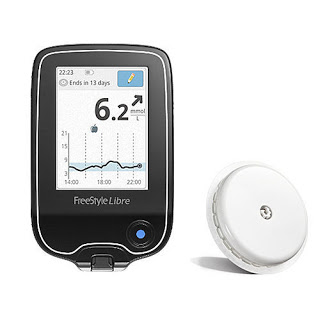The traditional way of monitoring blood sugars is with finger pokes, but there are other newer technologies out there that make it not only easier to check, but provide more data as well.
Two new technologies have recently arrived in Canada: the Freestyle Libre, which is a poke free glucose monitor, and the Dexcom5 continuous glucose monitor, which allows you to broadcast sugars wirelessly to family or caregivers. Today, we’ll review the Libre, and I’ll follow up with a separate post on the Dexcom5.
Finger pokes are uncomfortable, and can be a barrier to checking blood sugars.
As blogged previously, the Freestyle Libre system (pictured above) is an entirely new technology, consisting of a tiny monofilament sensor that you apply to your arm every 14 days. It measures glucose in the interstitial fluid that surrounds the cells under your skin, as an estimate of blood glucose levels. Hold the reader near the sensor and Ding! – it will tell you your current glucose level, which direction your sugar is heading (up, down, or steady), a message on the screen if glucose is going low or high, and – get this – it will show you your last 8 hours of glucose readings in a graph.
The Libre sensor is calibrated right out of the box, so there is no need for finger poking to calibrate it. It is approved by Health Canada for making treatment decisions, provided that you take into account all of the info on the screen when you scan the reader.
You DO need to check with a finger poke (built into the reader) if:
- sugar reads low or going low (very important, as the Libre may inaccurately indicate hypoglycemia)
- during a time of a rapid blood sugar change (for example during exercise, after eating, or after taking a bolus of insulin; the reason being because interstitial glucose changes lag behind blood glucose changes); or if your symptoms do not agree with the number you see when you scan (remember, though, that some people with diabetes are not able to feel it when their sugars go low – in that case, confirming with a finger poke may be needed more often)
It’s less accurate on the first day you wear it, so I would suggest more reliance on finger pokes on day 1. The accuracy improves to within about 9-11% of actual blood sugar after that. (Standard finger poke monitors have varying accuracy, and the analysis method for accuracy is different, but Diabetes Canada accepts within 15% accuracy for those monitors.) It costs about $50 for the reader (one time cost), and about $90 for each sensor (replaced every 14 days). There is a built in ketone meter as well, which is handy if there is a need to check ketones (more on this here).
The Libre provides the opportunity to decrease the need for finger pokes, and scanning just 3 times a day (every 8 hours) is enough to give a full 24h glucose profile, which can help you and your diabetes care providers understand your blood sugars in even more detail.
Stay tuned for info on the Dexcom5 continuous glucose monitor!
Disclaimer: I have received honoraria as a continuing medical education speaker and consultant from the makers of the Freestyle Libre (Abbott).
Follow me on twitter! @drsuepedersen












